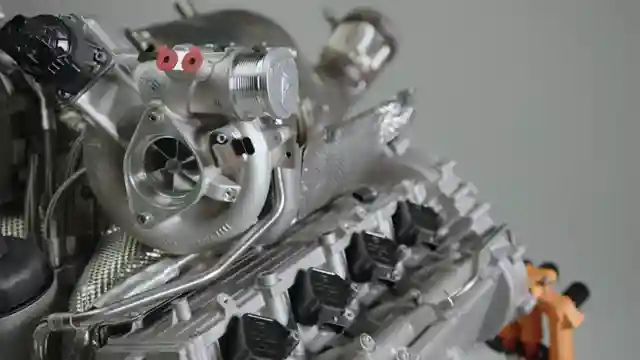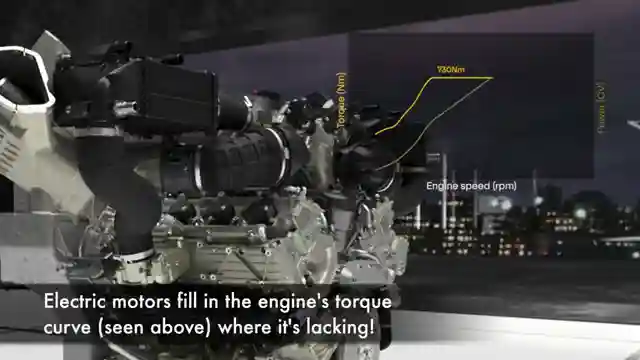Lamborghini Tamaro: Twin-Turbo V8 Engine Revving to 10,000 RPM

- Authors
- Published on
- Published on
- Name
- By Dushyant
- (@dishs)
In the world of supercars, Lamborghini has unleashed a beast - the Tamaro, powered by a groundbreaking twin-turbo V8 engine that revs to a mind-blowing 10,000 RPM. This move marks a departure from the iconic naturally aspirated V10, but Lamborghini's Chief Technology Officer explains that it was a necessary step to keep up with the competition. With Ferrari and McLaren pushing out more power from smaller engines, Lamborghini had to raise the stakes with a 4.0L turbocharged V8 that not only matches but surpasses its rivals.
What sets this engine apart is not just its sheer power output of 800 CV, but also the innovative integration of electric motors that provide additional torque and compensate for turbo lag. The result is a powertrain that delivers relentless acceleration and performance, thanks to a carefully designed system that optimizes power delivery at every RPM range. The Tamaro's engine design, unique to Lamborghini and boasting a hot V configuration, ensures efficient exhaust routing and cooling, setting it apart from the competition.
But what truly makes this engine special is its ability to rev to 10,000 RPM, a feat achieved through a combination of lightweight components, advanced valve train technology, and a compact yet powerful hybrid system. The finger follower valve train, diamond-like carbon coatings, and short timing chains all contribute to the engine's high-revving capability, while the hybrid system with a small battery pack adds a touch of electrification to the mix. Despite its weight, the Tamaro's performance speaks volumes, showcasing Lamborghini's commitment to pushing the boundaries of automotive engineering in the pursuit of raw power and exhilarating performance.

Image copyright Youtube

Image copyright Youtube

Image copyright Youtube

Image copyright Youtube
Watch Goodbye, V10 - Lamborghini Cranks A Turbo V8 To 10,000 RPM! on Youtube
Viewer Reactions for Goodbye, V10 - Lamborghini Cranks A Turbo V8 To 10,000 RPM!
Some users appreciate the high-revving internal combustion engines in the new Lamborghini model
Mention of Corvette Engineering achieving a masterstroke with the LT7 5.5 V8 engine
Discussion on the weight and complexity added by the three motors in the new Lamborghini model
Comparison to Porsche's electrically spooling turbos
Comments on the trend of increasing horsepower wars in cars
Suggestions for different engine configurations, such as V10 twin turbo or non-hybrid RWD version
Humorous comments on the video content and presentation
Criticism of the decision to downsize and go hybrid due to emission regulations
Concerns about the increasing weight and complexity of modern supercars
Speculation on the future maintenance and repair challenges of technologically advanced cars
Related Articles

Unveiling Corvette ZR1: Acceleration Secrets and Track Dominance
Engineering Explained reveals the Corvette ZR1's astonishing acceleration, custom launch control secrets, hidden red line, and exceptional handling capabilities, showcasing its dominance on the track.

GM Engine Failures: Thicker Oil Solution Revealed
Engineering Explained uncovers GM's engine failures due to manufacturing defects, recommending a switch to thicker oil for optimal engine performance and longevity.

Exclusive Review: Cadillac Celesteic Unveiled - Luxury & Innovation
Experience the Cadillac Celesteic: a $350,000 flagship sedan with 655 hp, 303 mi range, and unique manufacturing techniques like massive aluminum castings and 3D printed metal parts. Discover the luxury of low-volume production and innovative design in this exclusive review.

Revolutionizing Downforce: McMerry Spearling's Impact on Racing
The McMerry Spearling revolutionizes downforce creation with fan technology, showcasing remarkable efficiency and potential for Formula E and Formula 1.
